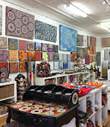- Products
- Artists
- About Us
-
Welcome to OzAboriginal Pty. Ltd.!
OzAboriginal was formed in 1992. Initially located in a warehouse that was primarily used for the distribution of Indigenous products, the organisation began to grow as new skills were learnt and a clear identity was formed. Local Indigenous artists joined the organisation that did traditional painting on artefacts, canvas and giftware. OzAboriginal, provides meaningful employment to local artists whilst allowing them the opportunities to develop their own artistic and commercial profile.

-
- Customer Service
-
Shipping
Shipping charges are based on the size and weight of the item. You will be shown the shipping and handling charges on the "Purchase Verification" page before you finalize your purchase.
Shop with Confidence
We ensure that the art-work shipped is insured for its full value. The cost of the same is however incorporated in the shipping and handling charges..
-
- Information
- Contact Us






